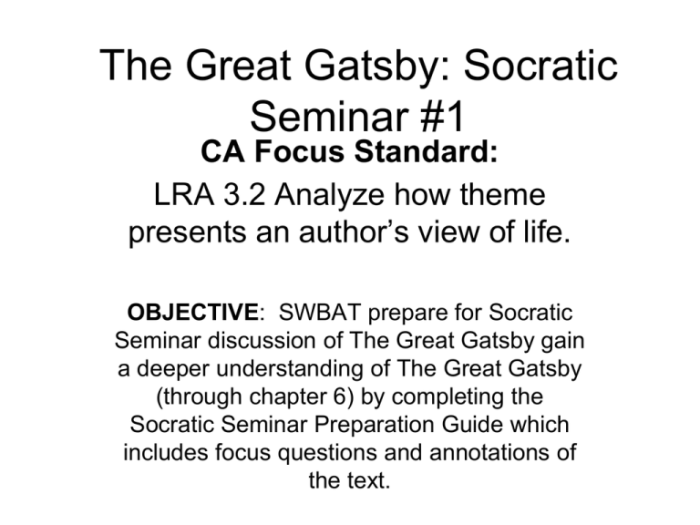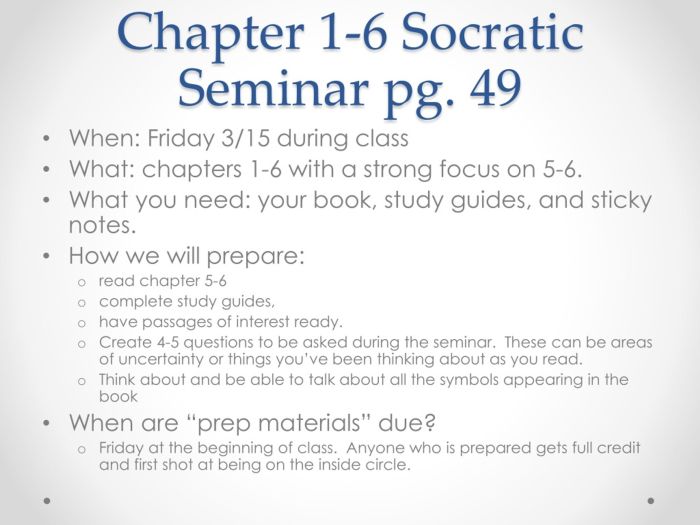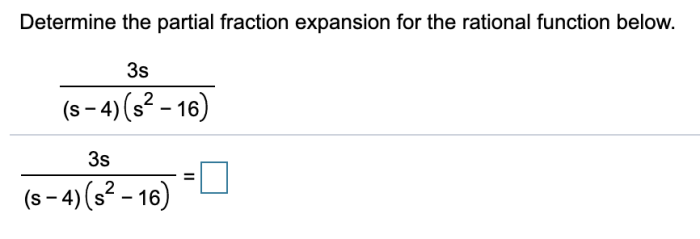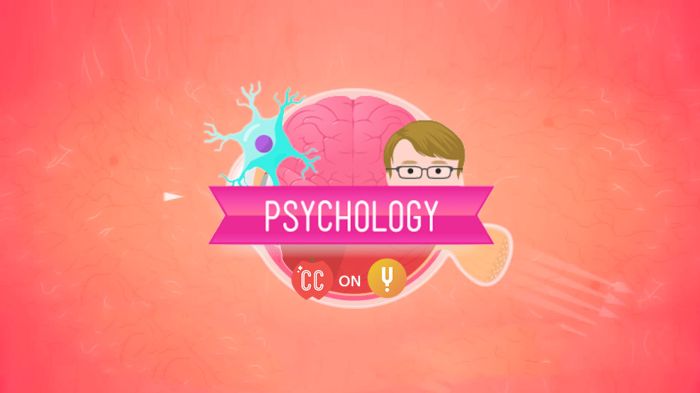Embark on a literary odyssey with The Great Gatsby Socratic Seminar Questions. Dive into the enigmatic world of Jay Gatsby and unravel the complexities of his motivations, the allure of Daisy Buchanan, and the insightful perspective of Nick Carraway. This exploration promises a journey through themes of love, wealth, and the elusive American Dream, all while navigating the rich symbolism woven throughout F.
Scott Fitzgerald’s masterpiece.
As we delve into the novel’s setting and social context, we will examine the impact of the Roaring Twenties and the stark class divisions that shape the characters’ lives. Through an analysis of Fitzgerald’s unique writing style and narrative structure, we will uncover the profound impact of literary devices such as foreshadowing, irony, and imagery.
Prepare to engage in thought-provoking discussions and gain a deeper appreciation for this timeless literary classic.
Character Analysis
Jay Gatsby, the enigmatic protagonist of The Great Gatsby, is a complex and multifaceted character. His motivations are a driving force in the novel, as he relentlessly pursues the American Dream and the love of Daisy Buchanan. Gatsby’s characterization highlights the transformative power of the past, the destructive nature of obsession, and the elusive nature of happiness.
Daisy Buchanan, the object of Gatsby’s affection, represents both the promise and the unattainability of the American Dream. Her beauty, wealth, and social status symbolize the ideal that Gatsby strives for, yet her own emotional detachment and shallowness ultimately lead to Gatsby’s downfall.
Nick Carraway, the novel’s narrator, serves as an observer and confidant to Gatsby. His perspective provides a window into the complexities of Gatsby’s character and the social landscape of the Roaring Twenties. Nick’s own journey of self-discovery parallels Gatsby’s, as he navigates the moral and ethical dilemmas of the novel’s world.
Themes and Symbolism
The Great Gatsbyexplores several major themes, including the American Dream, love, and wealth. The American Dream, a central tenet of American society, is portrayed as both a driving force and a source of disillusionment for the characters in the novel. Love, another recurring theme, is depicted as a powerful and transformative emotion, yet also capable of great pain and disappointment.
Fitzgerald employs a rich array of symbolism throughout the novel. The green light at the end of Daisy’s dock represents Gatsby’s unfulfilled hope and the unattainable nature of his dreams. The valley of ashes symbolizes the moral and economic decay beneath the glittering surface of the American Dream.
The eyes of Dr. T.J. Eckleburg, a billboard overlooking the valley of ashes, represent the watchful and judgmental eyes of God, a reminder of the moral consequences of human actions.
Setting and Social Context

The Great Gatsbyis set in the Long Island Gold Coast during the Roaring Twenties, a period of economic prosperity and social change. The novel vividly depicts the opulence and extravagance of the era, particularly among the wealthy elite of West Egg and East Egg.
However, Fitzgerald also explores the darker side of the Jazz Age, highlighting the social inequality, moral decay, and disillusionment that lurked beneath the surface.
The novel’s social hierarchy is clearly defined, with the wealthy elite at the top, followed by the middle class, and the working class at the bottom. Gatsby, an enigmatic figure who has risen from humble beginnings, struggles to gain acceptance into the upper echelons of society.
The novel explores the tensions and conflicts that arise from class divisions and the pursuit of social status.
Style and Structure: The Great Gatsby Socratic Seminar Questions

F. Scott Fitzgerald’s writing style in The Great Gatsbyis characterized by its lyrical beauty, evocative imagery, and precise language. His prose captures the glamour and excess of the Roaring Twenties, while also delving into the complexities of human emotions and motivations.
The novel’s structure is non-linear, employing flashbacks and multiple perspectives to gradually reveal the events and characters. This structure allows Fitzgerald to build suspense and provide insights into the characters’ past and present experiences. The novel’s opening chapter, which introduces Nick Carraway and his arrival in West Egg, serves as a framing device that sets the stage for the rest of the story.
Literary Devices
Fitzgerald employs a variety of literary devices in The Great Gatsbyto enhance the reader’s understanding and appreciation of the story. Foreshadowing is used throughout the novel to hint at future events, creating a sense of anticipation and suspense. For example, the description of Gatsby’s mansion as “a colossal affair by any standard” foreshadows the grandeur and extravagance of his lifestyle.
Irony is another prominent literary device in the novel. The juxtaposition of Gatsby’s wealth and status with his inability to achieve his ultimate goal creates a sense of tragic irony. Similarly, the characters’ pursuit of happiness often leads to disappointment and disillusionment, highlighting the ironic nature of their aspirations.
Imagery is a key element of Fitzgerald’s writing style. His vivid descriptions of the Roaring Twenties, from the opulent parties to the squalor of the valley of ashes, create a vivid and immersive setting for the novel. The green light at the end of Daisy’s dock, a recurring image throughout the novel, symbolizes Gatsby’s unfulfilled hope and the elusive nature of his dreams.
Top FAQs
What is the significance of the green light at the end of Daisy’s dock?
The green light symbolizes Gatsby’s hope and longing for Daisy, representing his unwavering belief in the possibility of rekindling their past love.
How does the character of Nick Carraway contribute to the novel’s narrative?
Nick serves as the narrator and provides an insider’s perspective on the events of the novel, offering insights into the characters and themes while maintaining a degree of objectivity.
What is the role of wealth and social status in The Great Gatsby?
Wealth and social status play a significant role in shaping the characters’ lives and relationships, highlighting the disparities and tensions within American society during the Roaring Twenties.







